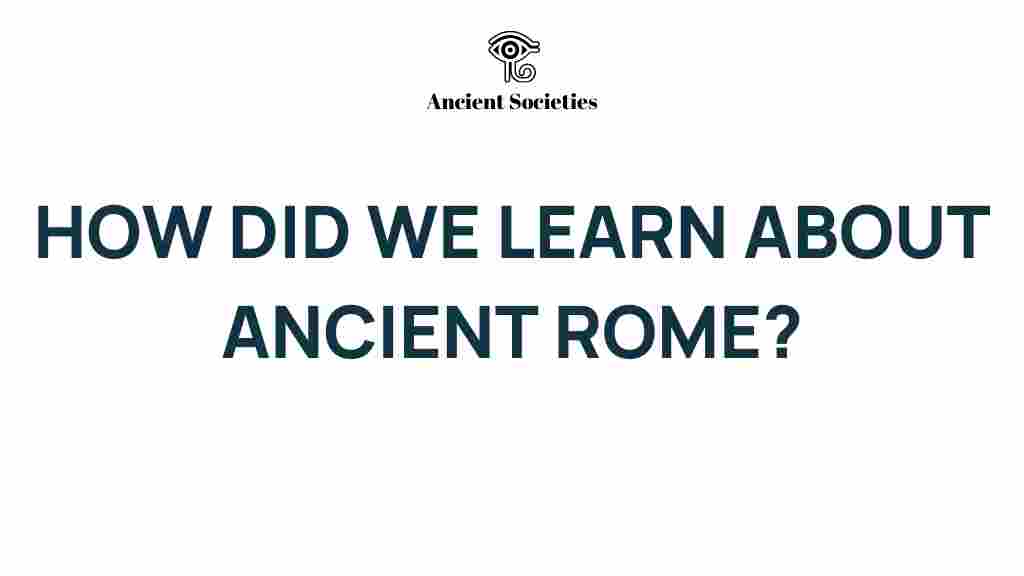Unveiling the Secrets: How We Discovered Ancient Rome’s Legacy
The legacy of Ancient Rome continues to captivate historians, archaeologists, and the general public alike. As one of the most influential civilizations in history, Ancient Rome’s contributions to culture, politics, architecture, and law have shaped the modern world in profound ways. In this article, we will explore how discoveries in archaeology have unveiled the secrets of this remarkable civilization, shedding light on its rich history, culture, and heritage.
The Importance of Archaeology in Understanding Ancient Rome
Archaeology serves as a vital tool for understanding the complexities of Ancient Rome. Through excavations, researchers uncover artifacts and structures that provide insight into the daily lives of Roman citizens, their customs, and their social structures. The following points highlight the significance of archaeological exploration:
- Revealing Everyday Life: Artifacts such as pottery, tools, and household items give us a glimpse into the daily routines and lifestyles of Romans.
- Understanding Social Structure: The layout of cities and the arrangement of homes can indicate social hierarchies and relationships within the civilization.
- Preserving Heritage: Through excavation and study, we can preserve the stories of those who lived in Ancient Rome, ensuring their legacy endures.
Key Discoveries in Ancient Roman Archaeology
Throughout the years, numerous discoveries have significantly advanced our understanding of Ancient Rome. Here are some of the most notable:
1. The Pompeii Excavations
One of the most famous archaeological sites is Pompeii, a city frozen in time after the eruption of Mount Vesuvius in 79 AD. The excavation of Pompeii has provided invaluable insights into Roman life:
- Preserved Artifacts: Frescoes, mosaics, and everyday items have been found in situ, allowing researchers to study Roman art and domestic life.
- Urban Planning: The layout of Pompeii demonstrates advanced urban planning and infrastructure, including roads, aqueducts, and public baths.
2. The Colosseum
The Colosseum, an iconic symbol of Ancient Rome, is not only a marvel of architecture but also a testament to Roman culture and entertainment. Recent excavations have revealed:
- Underground Structures: The hypogeum, a complex system of tunnels and chambers used to house gladiators and animals, has been extensively studied.
- Restoration Efforts: Ongoing restoration projects aim to preserve this heritage site for future generations.
3. The Roman Forum
The Roman Forum served as the heart of political, social, and economic life in Ancient Rome. Archaeological efforts have uncovered:
- Temples and Basilicas: The remains of important religious and civic buildings provide insight into Roman governance and spirituality.
- Public Spaces: The layout of the Forum reveals how Romans congregated for discussions, markets, and festivals.
How Archaeologists Conduct Their Work
The process of uncovering the secrets of Ancient Rome involves meticulous planning and execution. Here’s a step-by-step overview of how archaeologists approach their work:
Step 1: Site Selection
Archaeologists often begin by selecting sites based on historical records, previous discoveries, or local legends. This could include:
- Locations mentioned in ancient texts.
- Areas known for previous archaeological finds.
Step 2: Surveying
Once a site is chosen, archaeologists conduct surveys to assess the area. This includes:
- Mapping the landscape and identifying potential excavation sites.
- Using geophysical techniques to detect buried structures without disturbing the ground.
Step 3: Excavation
Excavation is a careful and systematic process. The techniques include:
- Digging in layers to preserve context and understand the chronological order of artifacts.
- Documenting each finding meticulously for future analysis.
Step 4: Analysis
After excavation, researchers analyze the artifacts and structures to interpret their significance. This involves:
- Dating artifacts using techniques like carbon dating.
- Comparing findings with existing historical records.
Troubleshooting Common Challenges in Archaeology
Archaeology is not without its challenges. Here are some common issues that archaeologists face and how they can address them:
1. Environmental Conditions
Weather can impact excavations, particularly in areas prone to flooding or extreme temperatures. To mitigate this:
- Plan excavations during favorable seasons.
- Utilize protective coverings and temporary structures during adverse weather.
2. Legal and Ethical Issues
Archaeologists must navigate legal restrictions and ethical considerations when working in historically significant areas. To ensure compliance:
- Work closely with local authorities and heritage organizations.
- Engage with the local community to promote awareness and support for preservation efforts.
3. Funding and Resources
Many archaeological projects depend on funding, which can be limited. To overcome this:
- Apply for grants from academic institutions, governments, and non-profits.
- Engage in crowdfunding initiatives to raise awareness and support.
The Role of Technology in Archaeology
Modern archaeology has been revolutionized by technology, enhancing our ability to uncover the secrets of Ancient Rome. Some of the technological advancements include:
- Remote Sensing: Techniques like LiDAR (Light Detection and Ranging) allow archaeologists to map ancient landscapes without excavation.
- 3D Modeling: Creating digital models of artifacts and sites helps in preservation and analysis.
- GIS (Geographic Information Systems): GIS technology assists in analyzing spatial relationships and patterns in archaeological data.
Preserving Ancient Roman Heritage
Preservation of the discoveries made through archaeology is crucial for maintaining the legacy of Ancient Rome. Key strategies include:
- Conservation Efforts: Implementing measures to protect artifacts from deterioration.
- Public Engagement: Educating the public about the importance of preserving archaeological sites through programs and workshops.
- Legislation: Advocating for laws that protect cultural heritage sites from development and destruction.
Conclusion
In conclusion, the exploration of Ancient Rome through archaeology unveils the rich tapestry of its history, culture, and civilization. Each discovery, from artifacts to architectural remnants, adds to our understanding of this influential society. As we continue to explore and study these findings, we not only preserve the legacy of Ancient Rome but also enrich our understanding of human history.
For more information on archaeological practices and discoveries, consider visiting the Archaeological Institute of America. To delve deeper into the history of Rome, check out this comprehensive resource on Roman civilization.
This article is in the category Archaeology and created by AncientSocieties Team
